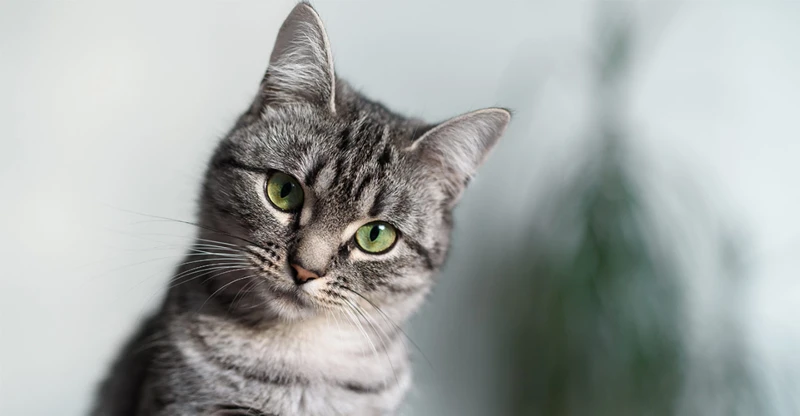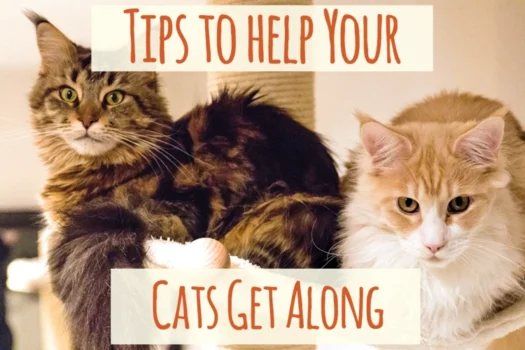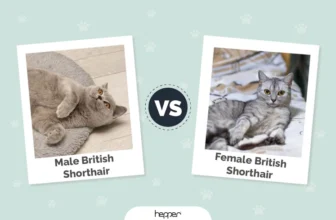Welcoming a new furry friend into your home can be an incredibly exciting and joyous time. However, it can also come with its own set of challenges, particularly if your American Shorthair is showing signs of fear or anxiety around other animals. It’s important to understand that fear is a natural response for cats, especially those who haven’t been properly socialized or have had negative experiences in the past. In this article, we’ll provide you with actionable steps on how to help your American Shorthair overcome their fear of other animals and become a well-adjusted member of your family. So, let’s dive in and learn how to create a happy and harmonious environment for both you and your furry friend.
Understanding Your American Shorthair’s Fear

As a pet owner, understanding your American Shorthair’s fear of other animals can be perplexing and frustrating. It can be challenging to watch your furry friend cower or lash out in the presence of other pets. While it’s tempting to scold or punish your cat for their anxious behavior, it’s essential to identify the root cause of their fear before taking corrective action. Fortunately, there are effective methods for helping your American Shorthair overcome their fear of other animals. By implementing the following tips and tricks, you can help your furry friend feel safer and more secure around other pets and animals. Let’s explore how to recognize the signs of fear, determine its causes, and provide your American Shorthair with the support they need.
Recognizing the Signs
Recognizing the signs that your American Shorthair is fearful of other animals is the first step in helping them overcome their fear. While some signs may be obvious, others may be more subtle. Some common signs of fear in cats include:
| Signs of Fear in American Shorthair Cats |
| • Hiding or running away from other animals |
| • Aggressive behavior, such as hissing, growling, or swatting |
| • Avoiding eye contact with other animals |
| • Raised fur or tail, indicating that they are on high alert |
| • Meowing excessively or making other vocalizations |
| • Tensed body posture or crouching |
If you notice any of these signs in your American Shorthair when they are around other animals, it is likely that they are experiencing fear. It is important to recognize these signs early on, as prolonged fear can lead to anxiety and other behavioral problems for your cat.
Understanding why your American Shorthair is afraid of other animals is important in figuring out how to help them. The next section will cover some common causes of fear in cats, which may help you determine the underlying issue that is causing your cat’s fear.
Determining the Cause
It’s important to determine the cause of your American Shorthair’s fear of other animals in order to effectively help them overcome it. Fear can be caused by a variety of factors, such as a previous negative experience, lack of socialization, or even genetics. Here are some steps to help determine the cause of your cat’s fear:
Observe their behavior: Take note of how your American Shorthair acts when they are around other animals. Do they become aggressive, hide, or hiss? This can help you determine if their fear is rooted in anxiety, aggression, or fear.
Consider their past experiences: Think about any previous interactions your American Shorthair has had with other animals. Did they have a bad experience, such as being chased or attacked? This could be a contributing factor to their fear.
Assess their socialization: American Shorthairs that were not socialized with other animals at an early age may be fearful. If you adopted your cat as an adult, it’s possible that they never had the opportunity to learn how to properly interact with other animals.
Consult your vet: A visit to your vet can help rule out any underlying medical conditions that may be causing your cat’s fear.
By determining the cause of your American Shorthair’s fear, you can take the necessary steps to help them overcome it. For example, early socialization with other cats and dogs can greatly reduce a cat’s fear of them. To learn more about early socialization, check out our article on the importance of early socialization for American Shorthair kittens.
Tips for Helping Your American Shorthair Overcome Fear

As a loving and responsible pet owner, it can be difficult to see your American Shorthair struggling with fear and anxiety, especially when it comes to interactions with other animals. However, it’s important to understand that this is a common issue and there are steps you can take to help your furry friend feel more comfortable and confident. In this section of the article, we’ll provide some tips and strategies for helping your American Shorthair overcome fear and build healthy relationships with other animals. Whether you’re looking to introduce your American Shorthair to a new dog, teach them to get along with cats, or simply cope with their fear and aggression, these tips will help you create a safe and supportive environment for your pet.
Start Slow and Gradual
When you’re helping your American Shorthair overcome their fear of other animals, it’s essential to start slow and gradual. Introducing them too quickly to other pets could make their fear even worse. It’s important to build up their confidence in a comfortable and controlled environment. Start by bringing your American Shorthair to the same room as another animal without allowing them to interact. This simple exposure helps them get used to the presence of another animal.
Here are some more tips on how to start slow and gradual:
- Allow your American Shorthair to approach the other animal gradually on their terms.
- Keep interactions short and supervised.
- If your American Shorthair becomes too agitated or scared, remove them from the situation.
- Gradually increase the amount of time your American Shorthair spends around other animals.
- Be patient and take things slowly. Every cat will react differently, so it’s important to let them work at their own pace.
For example, if you want to introduce your American Shorthair to a dog, start by just simply letting them be in the same room together for a little while without any interaction. Make sure they both have their own space, so they feel safe. Gradually allow them to become more familiar with each other, always making sure to supervise their interactions.
Remember, slow and gradual exposure is key to helping your American Shorthair overcome their fear of other animals. It will help build their confidence and increase their comfort level around other pets. This will be essential for any successful socialization.
Continue reading: Check out our article on How to Introduce Your American Shorthair to a Dog.
Utilize Positive Reinforcement
When helping your American Shorthair overcome their fear of other animals, positive reinforcement can be an effective tool to use. Positive reinforcement involves rewarding your American Shorthair for exhibiting good behavior. This can be done through treats, praise, or play.
Here are some ways to utilize positive reinforcement when helping your American Shorthair overcome their fear of other animals:
- When your American Shorthair is in the presence of another animal but remains calm, reward them with a treat or praise.
- If your American Shorthair shows signs of fear but is not aggressive, try to redirect their attention with a toy or treat and reward them for engaging with it rather than reacting fearfully towards the other animal.
- If your American Shorthair displays friendly behavior towards another animal, such as sniffing or playing, reward them with praise or playtime.
By using positive reinforcement, you can help your American Shorthair associate being around other animals with good things, rather than fear or anxiety. This can make them more comfortable and less fearful over time.
It’s important to remember that positive reinforcement should always be used in conjunction with other tips for helping your American Shorthair overcome their fear, such as starting slow and providing safe spaces.
If you need further assistance with your American Shorthair’s fear of other animals, consider seeking professional help. A veterinarian or animal behaviorist can offer additional guidance and support.
For more information about teaching your American Shorthair to get along with other cats, read our article “/teach-as-get-along-cats/”. If you’re experiencing conflict between your American Shorthair and other animals, check out our article “/coping-with-aggression-americanshorthair-conflict/”. And for tips on providing safe spaces for playtime, read our article “/safe-space-american-shorthair-playtime/”.
Provide Safe Spaces
American Shorthairs can feel a bit overwhelmed when they are around other animals. To help your feline friend feel more at ease, it’s a good idea to provide safe spaces. These spaces can give them an area to retreat to when they are feeling frightened. Here are a few things to consider when creating a safe space for your American Shorthair:
| Tip | Description |
|---|---|
| Location | Choose a quiet, secluded spot in your house for the safe space. This can be a closet, unused room, or even a cozy cat bed in a low-traffic area of your living space. |
| Size | The safe space should be large enough for your American Shorthair to move around in. Make sure there is enough room for their litter box, food, water, and a comfortable bed or blanket. |
| Comfort | Make sure there are soft, comfortable items inside the safe space. This can be bedding, blankets, or even soft toys for your American Shorthair to snuggle up with. |
| Access | Make sure the safe space has easy access for your American Shorthair. Provide enough room for them to move in and out without difficulty. You can also add a cat door or other entryway to make it easier for them to get in and out of the safe space. |
| Comfort objects | Add scented items such as toys, bedding, blankets to help your American Shorthair feel more at home and relaxed. |
It’s important to remember that each American Shorthair is unique, and what works for one may not work for another. Be patient and observant as you determine what kind of safe space works best for your cat. Keep in mind that safe spaces are just one part of helping your American Shorthair overcome their fear of other animals. For best results, use these tips in combination with other effective techniques.
Seek Professional Help if Needed
It can be difficult to determine the root cause of your American Shorthair’s fear of other animals and to address it on your own. If you have tried the tips discussed above or if your cat’s fear seems severe, seeking professional help may be necessary.
- Consider reaching out to a veterinarian or animal behaviorist for guidance.
- Some signs that your cat may need professional help include:
- Persistent fear or aggression towards other animals
- Fear or aggression towards humans
- Excessive meowing, pacing, or other anxious behaviors
- Inappropriate urination or defecation
- A professional can:
- Evaluate your cat’s behavior and determine the underlying cause of their fear
- Create a customized behavior modification plan to help your cat overcome their fear of other animals
- Prescribe medication, if necessary, to help mitigate your cat’s fear and anxiety
- It’s important to remember that seeking professional help is not a sign of failure.
- It shows that you are committed to helping your cat overcome their fear and provide them with the best care possible.
Remember, patience and persistence are key when helping your American Shorthair overcome their fear of other animals. Even if you need to seek professional help, with time and the right approach, your cat can learn to socialize and interact with other animals in a positive and healthy way.
How to Socialize Your American Shorthair with Other Animals

If you’re a cat owner, you likely understand the importance of helping your American Shorthair feel comfortable and confident around other animals. Whether you’re introducing a new pet into your household or simply want to take your furry friend on outings with other animals, socialization can significantly improve their quality of life. However, the process of socializing cats can be a bit overwhelming and confusing for pet owners. Luckily, by following a few simple tips and strategies, you can help your American Shorthair overcome their fear of other animals and learn to enjoy socializing with their furry counterparts. Let’s dive in!
Introducing Your American Shorthair to Other Animals
When introducing your American Shorthair to other animals, it’s important to proceed with caution in order to prevent any negative encounters. Here are some steps to follow:
Step 1: Choose a Calm Environment
Choose a quiet and calm environment for the first introduction. This can be a room in your home that your cat is comfortable with or a neutral location such as a park.
Step 2: Use Positive Reinforcement
Before introducing your cat to the other animal, offer your cat a treat to reinforce good behavior. This can help create a positive association with the other animal.
Step 3: Use a Leash or Carrier
For dogs or cats, use a leash or carrier to control any unexpected movements and prevent either animal from feeling threatened. Make sure to introduce the animals through a barrier initially.
Step 4: Allow for Sniffing and Exploration
When both animals seem comfortable, allow them to sniff and explore each other’s scents. Supervise this interaction closely and be prepared to separate them if necessary.
Step 5: Relax and Monitor
If the introduction seems to be going well, allow the animals to interact freely while monitoring them closely. However, if the interaction becomes aggressive or uncomfortable for either animal, remove them from each other.
By following these steps and introducing your American Shorthair to other animals in a controlled and positive way, you can help your cat become more comfortable and social with other animals.
Supervising Playtime and Interactions
When it comes to socializing your American Shorthair with other animals, it is important to supervise playtime and interactions to ensure that they remain safe and positive experiences. Here are some tips to help you do that:
- Stay Alert: Never leave your American Shorthair alone with another animal. Always supervise their interactions and be ready to intervene if needed.
- Watch Body Language: Keep an eye on your American Shorthair’s body language, as well as that of the other animal. Look for signs of fear, aggression, or discomfort, and separate them if necessary.
- Encourage Positive Play: Reward your American Shorthair for good behavior during playtime. If they get along well with another animal, give them treats or toys as positive reinforcement.
- Keep Things Short and Sweet: Limit playtime with other animals to short periods, especially at first. Gradually increase the length and frequency of their playtime as they become more comfortable with each other.
- Take a Break: If your American Shorthair seems stressed or anxious during playtime, take a break and try again later. Don’t force them to interact if they don’t want to.
By following these tips, you can help make playtime with other animals a positive experience for your American Shorthair, and help them overcome their fear of other animals in a safe and gradual way.
Continuing Socialization and Reinforcement
Once you have successfully introduced and socialized your American Shorthair with other animals, it is important to continue reinforcing their positive behavior and socialization skills. This will help ensure that your cat maintains their newfound confidence and comfort around other animals. Here are some tips to continue socialization and reinforcement:
| Tip | Description |
|---|---|
| Reinforce positive behavior | Whenever your American Shorthair interacts positively with other animals, be sure to reward them with praise and treats. This will reinforce their good behavior and encourage them to continue to socialize with other animals. |
| Provide opportunities for socialization | Continue to provide your American Shorthair with opportunities to socialize with other animals. This can include playdates with other pets or visits to a dog park or cat cafe. Consistent exposure to other animals will help them build their confidence and socialization skills. |
| Monitor their behavior | Always keep an eye on your American Shorthair’s behavior around other animals. This will allow you to intervene if necessary and prevent any negative interactions or behavior from developing. If you notice any signs of fear or aggression, take a step back and provide more gradual socialization opportunities. |
| Be patient and consistent | Remember that socialization takes time and patience. Be consistent in your approach and continue to work with your American Shorthair to build their confidence and socialization skills. With time and patience, your cat can overcome their fear of other animals and build positive relationships with furry friends. |
By following these tips for continuing socialization and reinforcement, you can help your American Shorthair maintain positive relationships with other animals and overcome their fear. Remember to be patient, consistent, and always monitor their behavior around other pets. With time and care, your cat can become confident and comfortable in the presence of other animals.
Mistakes to Avoid
As a pet owner, it’s important to approach your American Shorthair’s fear of other animals with care and understanding. While there are several tips and techniques you can use to help your feline friend overcome these fears, it’s equally important to avoid making mistakes that could hinder their progress or even make their fear worse.
Avoid Forcing Your American Shorthair to Interact with Other Animals – It’s important to remember that every animal, including your American Shorthair, has their own unique personality and comfort level. Forcing them to interact with other animals when they are not ready can be a traumatic experience. This can cause them to associate other animals with fear or anxiety, making it even harder to overcome their fear in the future.
Avoid Punishing Your American Shorthair – Negative reinforcement such as punishment or scolding should be avoided entirely when working with a fearful cat. This can create a negative association with other animals and reinforce their fear. Instead, focus on positive reinforcement techniques outlined earlier in the article.
Avoid Allowing Other Animals to Terrify Your American Shorthair – Socialization can be a slow and gradual process for fearful cats, so it’s important to keep interactions positive and safe. Don’t let other animals bully or intimidate your pet, as this can lead to further fear and anxiety.
Avoid Rushing the Process – Remember that overcoming fear is a process that takes time and patience. Don’t rush your American Shorthair into situations they are not ready for. Gradually increase exposure to other animals, always keeping an eye out for signs of fear and discomfort.
By avoiding these common mistakes, you can create a more positive and successful environment for your American Shorthair to overcome their fear of other animals. Remember to always approach socialization with patience and consistency, and seek professional help if needed. With time and effort, your feline friend can learn to feel more comfortable around other animals and enjoy a happier, more social life.
Conclusion
After reading this article, you should now have a better understanding of how to help your American Shorthair overcome their fear of other animals. Remember, it is important to approach this process with patience and a positive attitude. It may take some time and effort, but the end result of a happy, well-adjusted cat who is able to interact with other animals is worth it.
Recognizing the signs of fear is the first step in helping your cat. Watch for behavioral changes such as hiding, hissing, growling, or avoiding interaction with other animals.
Determining the cause of your cat’s fear is important in creating a plan to help them overcome it. Whether it is due to past experiences, lack of socialization, or their individual personality, understanding the root cause can help guide your approach.
Starting slow and gradual is key in helping your cat become comfortable around other animals. Take small steps and reward positive behavior to build confidence.
Using positive reinforcement can help incentivize your cat to engage in desired behaviors. Treats, toys, and lots of praise can go a long way in helping your cat feel more comfortable around other animals.
Providing safe spaces for your cat to retreat to can help them feel secure and ease their anxiety around other animals. This can be a designated room, bed, or hideout.
Seeking professional help if your cat’s fear is severe or impacting their daily life is a valid option. Your veterinarian or a professional animal behaviorist can provide guidance and support.
Introducing your American Shorthair to other animals should be done carefully and gradually. Supervision is key to ensuring the safety of all animals involved.
Continuing socialization and reinforcement can help solidify your cat’s comfort around other animals. Ongoing positive experiences and encouragement can help them feel more at ease.
Avoiding common mistakes such as forcing interactions or neglecting to supervise playtime can hinder your cat’s progress in overcoming their fear.
In conclusion, helping your American Shorthair overcome their fear of other animals is a process that requires patience and positivity. With the guidance provided in this article, you can help your cat become more comfortable and confident in a multi-animal household, leading to a happier and healthier life for both them and their furry friends.
Frequently Asked Questions
What are some common reasons for an American Shorthair to develop a fear of other animals?
Some common reasons include past negative experiences with other animals, lack of proper socialization as a kitten, and genetic disposition towards fearfulness.
What signs should I look for to recognize if my American Shorthair is fearful of other animals?
Signs can include hiding, hissing or growling, flattened ears, dilated pupils, and aggressive behavior.
How can I determine the cause of my American Shorthair’s fear of other animals?
Consulting with a veterinarian or animal behaviorist can help determine the cause and develop a treatment plan to help your pet overcome their fear.
What is the best way to start helping my American Shorthair overcome their fear of other animals?
Start slow and gradual, exposing your pet to other animals in a controlled and positive environment. This can help build their confidence and decrease their fear.
How can I use positive reinforcement to help my American Shorthair overcome their fear?
Using treats, praise, and other rewards can help encourage positive behavior and reinforce good interactions with other animals.
Why is providing safe spaces important for an American Shorthair with a fear of other animals?
Having a designated safe space can help your pet feel more secure and give them a sense of control in their environment. This can reduce stress and anxiety when around other animals.
When should I consider seeking professional help for my American Shorthair’s fear of other animals?
If your pet’s fear is severe or impacting their quality of life, consulting with a veterinarian or animal behaviorist can provide additional resources and support for their treatment.
How can I introduce my American Shorthair to other animals in a safe and controlled manner?
Using a gradual and controlled approach, allow your pets to interact with each other in short periods of time with close supervision. Reward positive behavior and intervene if necessary to ensure safety.
What should I do if my American Shorthair reacts negatively during playtime with other animals?
Interrupt the behavior, separate the animals, and redirect their focus to a positive activity. Avoid punishing your pet and seek professional help if the behavior continues.
Can my American Shorthair’s fear of other animals effectively be treated?
With patience, persistence, and proper treatment, most pets can overcome their fear of other animals and develop positive relationships with them.







